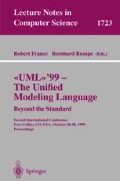Abstract
We use UML timed Sequence Diagrams to specify the real-time behaviour of a communication protocol of audio/video components. The Sequence Diagrams build the requirements specification against which an implementation of the protocol developed by the Bang & Olufsen company is proven correct.
To obtain a complete requirements specification, we have to mark the UML Sequence Diagrams as optional or mandatory behaviour. Then the Sequence Diagram interactions with their timing constraints and periods are transferred to a setting of timed automata. We use the Uppaal tool for verification. In particular, we show that the implementation of the protocol conforms to the Sequence Diagram specification concerning the correct data transfer on the bus.
This author was supported by the DFG project EREAS
Access this chapter
Tax calculation will be finalised at checkout
Purchases are for personal use only
Preview
Unable to display preview. Download preview PDF.
References
Rajeev Alur and David L. Dill. A theory of timed automata. Theoretical Computer Science, 126:183–235, 1994.
Rajeev Alur, Gerard J. Holzmann, and Doron Peled. An analyzer for Message Sequence Charts. In Tiziana Margaria and Bernhard Steffen, editors, Tools and Algorithms for the Construction and Analysis of Systems (TACAS’96), volume 1055 of LNCS, pages 35–48. Springer-Verlag, 1996.
Grady Booch, james Rumbaugh, and Ivar Jacobson. The Unified Modeling Language User Guide. Addison-Wesley, 1999.
Werner Damm and David Harel. LSCs: Breathing life into Message Sequence Charts. In 3rd IFIP Int. Conference on Formal Methods for Open Object-Based Distributed Systems, (FMOODS’99), pages 293–312. Kluwer Academic Publishers, 1999.
Bruce P. Douglass. Real-Time UML. Addison-Wesley, 1998.
Vincent Encontre. Modeling and implementing correct, scalable and efficient real-time applications with ObjectGEODE. 1rst Quarter Edition of Real-Time Magazine, 1996.
Gerard J. Holzmann and Doron Peled. The state of SPIN. In 8th International Conference on Computer Aided Verification, volume 1102 of LNCS, pages 385–389, New Brunswick, NJ, USA, 1996. Springer Verlag.
Klaus Havelund, Arne Skou, Kim G. Larsen, and Kristian Lund. Formal modelling and analysis of an audio/video protocol: An industrial case study using UPPAAL. In Proceedings of the 18th IEEE Real-Time Systems Symposium, pages 2–13, 1997.
Agnès Lanusse, Sébastian Gérard, and Francois Terrier. Real-time modelling with UML: The ACCORD approach. In UML’ 98, volume 1618 of LNCS, pages 287–296. Springer-Verlag, 1998.
Stefan Leue and Gerard Holzmann. v-Promela: A visual, object-oriented language for SPIN. In Proc. of the 2nd IEEE Intern. Symp. on Object-Oriented Real-Time Distributed Computing. IEEE Computer Society Press, 1999.
Kim G. Larsen, Paul Pettersson, and Wang Yi. Diagnostic model-checking for real-time systems. In Proc. of the 4th DIMACS Workshop on Verification and Control of Hybrid Systems, volume 1066 of LNCS, pages 575–586. Springer-Verlag, 1995.
Kim G. Larsen, Paul Pettersson, and Wang Yi. UPPAAL in a nutshell. Intern. Journal on Software Tools for Technology Transfer, 1(1+2), 1997.
Bran Selic, Garth Gullekson, and Paul T. Ward. Real-Time Object-Oriented Modeling. John Wiley & Sons, 1994.
J. Seemann and J. Wolff von Gudenberg. Extension of UML Sequence Diagrams for real-time systems. In UML’ 98, volume 1618 of LNCS, pages 225–233. Springer-Verlag, 1998.
Author information
Authors and Affiliations
Editor information
Editors and Affiliations
Rights and permissions
Copyright information
© 1999 Springer-Verlag Berlin Heidelberg
About this paper
Cite this paper
Firley, T., Huhn, M., Diethers, K., Gehrke, T., Goltz, U. (1999). Timed Sequence Diagrams and Tool-Based Analysis — A Case Study. In: France, R., Rumpe, B. (eds) «UML»’99 — The Unified Modeling Language. UML 1999. Lecture Notes in Computer Science, vol 1723. Springer, Berlin, Heidelberg. https://doi.org/10.1007/3-540-46852-8_45
Download citation
DOI: https://doi.org/10.1007/3-540-46852-8_45
Published:
Publisher Name: Springer, Berlin, Heidelberg
Print ISBN: 978-3-540-66712-4
Online ISBN: 978-3-540-46852-3
eBook Packages: Springer Book Archive

